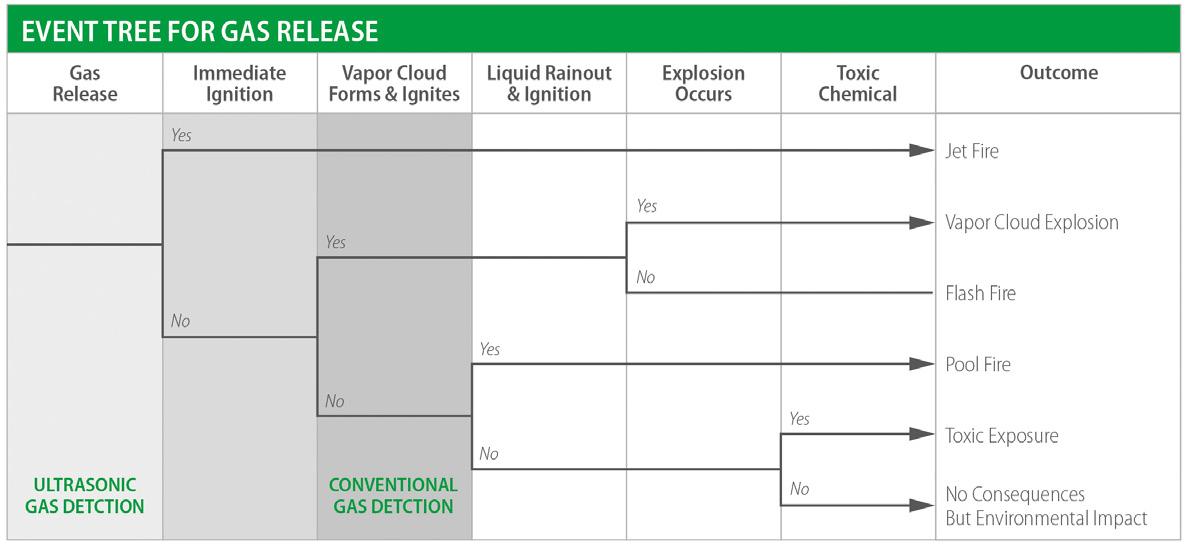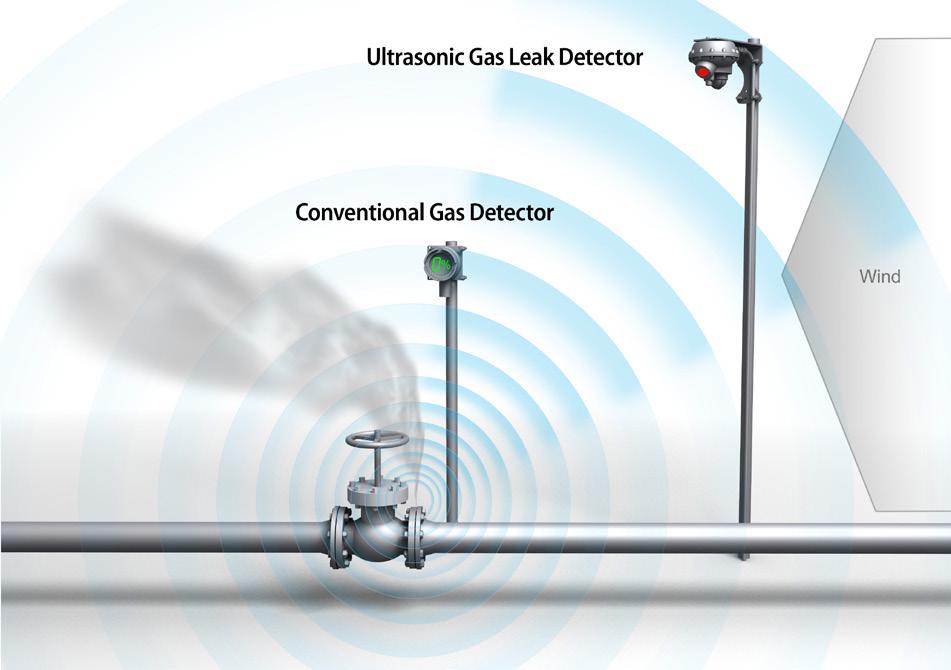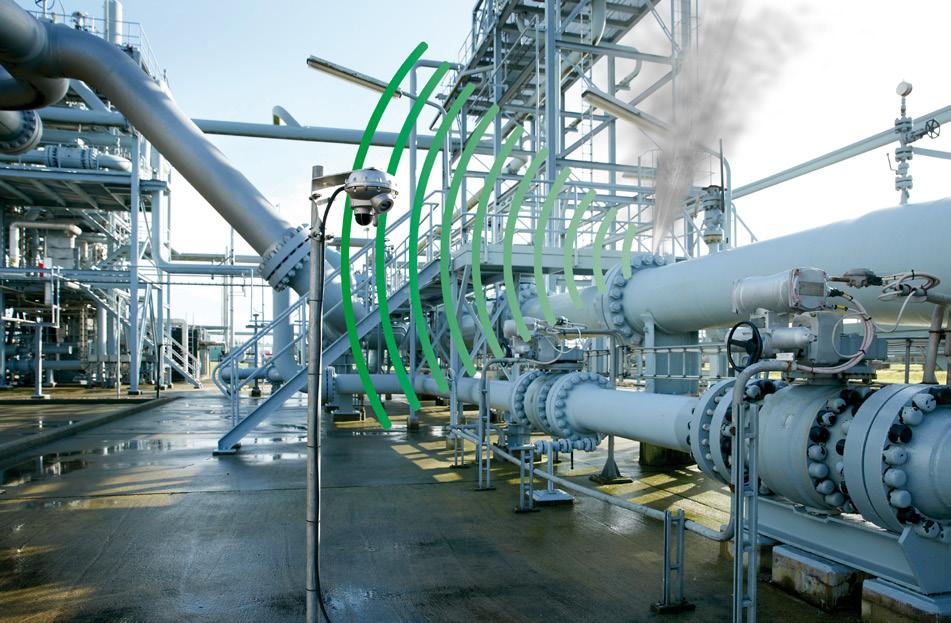
9 minute read
Gas detection at the speed of sound
Andrzej Janowski, MSA Safety, Poland, outlines how ultrasonic gas leak detectors provide an additional layer of protection in LNG facilities, and how pairing this with artificial neural network technology can contribute towards more reliable detection of a gas leak.
ltrasonic gas detectors improve process safety with faster, more reliable detection of high-pressure natural gas leaks. Process and plant engineers tasked with improving the safety of natural gas industry production and distribution operations are today employing a variety of gas leak sensing technologies. Mapping engineers need to design gas detection systems to protect people, equipment, and facilities by increasing the probability of detection and alarming. The consequences of not detecting gas leaks early can be disastrous and, depending on when they are detected, will determine the outcome, as can be seen in the event tree in Figure 1.
The traditional sensor technologies for methane gas leak detection within the LNG industry are: catalytic bead and infrared (IR) point detectors, and either IR or laser-based open path gas detectors. They are all well-known technologies with decades of proven performance in the field.
All of them have their unique advantages depending on the target gas, application, and environment. They also have their limitations, and to be able to detect the gas leak, they rely on the gas cloud migrating to the sensor. Due to a variety of reasons, these gas detectors may fail to detect a gas leak. This could be due to inadequate fire and gas mapping – either an insufficient quantity of sensors or their incorrect placement, the selection of gas detectors which are not fail-safe and when the sensor dies it does not go into fault, or the most likely scenario, which is the wind blows the gas away from the detector (Figure 2) or strong winds dilute the concentration below the alarm level. Truly dangerous pressurised gas leaks can be a challenge to detect
reliably by anyone using any of the conventional catalytic bead, point IR, and open path gas sensing technologies. Although some gas leak releases make a jet-like noise, operators may not be nearby to hear the escaping gas. Given the challenges that conventional gas sensors face in detecting high-pressure gas releases in outdoor environments, it is not surprising that ultrasonic gas leak detectors (UGLDs) are becoming more widely specified. Along with the conventional gas detectors, UGLDs are being used as part of the new design concept, which incorporates ‘multiple layers of protection’. The optimal design for high-risk applications incorporates point, open path, and ultrasonic gas detectors.
UGLDs offer a number of advantages including immunity to gas dispersion from wind, which is a serious limitation with point and open path sensing solutions. Instead, UGLDs detect the gas release as soon as it starts by instantly hearing the sound the leak makes. As UGLDs do not have to wait for the gas cloud to reach the sensor and then reach a high enough concentration to activate the first alarm, this saves valuable time in alerting the control room of the gas leak. This could be a few seconds or a few minutes faster than conventional gas detectors, which in some cases may never detect the gas leak.
Ultrasonic leak detection in natural gas applications
UGLDs are used today on offshore platforms, onshore processing plants, and compressor and metering stations along pipelines, including various LNG facilities. Due to the nature of LNG and low storage pressure, UGLDs are recommended for installation at the point of regasification, within gas turbine skids and enclosures, and during the LNG liquefaction process where pressurised refrigerants are used.
They are highly effective in protecting compressor stations which carry essential tasks in the natural gas network after the regasification stage, as they transport greater volumes of the raw material from the LNG terminal to the domestic or commercial gas transmission network. Compressor stations are placed strategically within the gathering and transportation pipeline network to help maintain the pressure and flow of gas to end users. Their strategic importance for the correct functioning of the entire network requires the best safety solution for the early detection of dangerous compressed gas leaks.
Variable background noise problem
Being non-contact measurement devices, UGLDs protect against both combustible and toxic gas releases, and their detection range can be verified by using inert gases with similar molecular weight and heat ratio as those of the gases of interest.
In ultrasonic gas detection, a sound wave is simply a pressure pulse in the air that is detected by the human ear the same way that it is detected by a microphone. The human ear can only perceive acoustic sound waves in the frequency range between 20 – 20 000 Hz (20 kHz), and that is why this frequency range is called the audible frequency range. Acoustic sound frequencies above 20 kHz are called ultrasound.
When pressurised methane is released through a leak, the hissing noise produced is called broadband acoustic noise, ranging from the audible frequency range into the ultrasonic frequency range. Earlier generations of UGLDs only ‘listened’ for the gas leak noise in the ultrasonic frequency range from approximately 25 kHz and above.
UGLDs measure the sound pressure produced by the escaping gas. As the sound pressure exceeds a pre-set level normally produced by background noise, the detector indicates an alarm condition. Such threshold-crossing devices essentially record deviations from baseline conditions early enough to detect dangerous leaks of pressurised gases and to initiate appropriate warnings.
Despite the advantages of threshold monitoring, the performance of today’s conventional ultrasonic gas leak detector depends on an assumption of a fixed background ultrasound level at a particular installation. Likewise, the alarm delay setting on such devices is based on a presumption of intermittent ultrasonic sources (false positives) that are fixed in duration. In any industrial environment, such background conditions may vary in terms of both magnitude and duration. Furthermore, as operators seek to avoid frequent changes to configured devices, pre-set sound pressure thresholds and alarm delays significantly limit the instruments’ detection range and speed of response.
Real gas leak detection
Figure 1. Gas release event tree. To overcome these limitations, more advanced UGLDs have been developed and incorporate artificial neural network (ANN) intelligence. This new UGLD design distinguishes the broadband ultrasound produced by pressurised gas releases from other artificial and natural sources. Such a design can be implemented with or without a threshold-crossing scheme, enhancing the scaleability of gas leak detection.
For convenience, the detector can operate with the threshold-crossing scheme or one of several enhanced modes that rely on ANN to classify ultrasound signals. Furthermore, testing results show that the UGLD with the ANN algorithm achieves a longer detection range (radius approximately 28 m) and a shorter response time in the presence of ultrasonic background noise. An ANN operates in a manner very similar to how the human brain handles the constant flow of information. When meeting a person, the brain receives a massive amount of visual information through the eyes, and, over time, this substantial amount of information is used to recognise this person years later or even to identify further family members. In other words, the more the brain is trained to recognise familiarity, the better a person will be able to recognise or deny another person’s face. The brain does not look for an exact match, it looks for familiarity, and so does the ANN.

Like the brain, however, the neural network needs to be trained first. The UGLD needs to be trained to recognise the sound signature from a gas leak effectively while at the same time rejecting sound signatures from acoustic background noises that are not related to gas leaks.
Acoustic noise from a real gas leak source normally ranges from 10 kHz and up to the 60 – 70 kHz range. Acoustic noise from a false alarm source, such as a gas compressor for example, can easily generate high level frequencies in the range of 100 Hz – 20 kHz.
Earlier generations of UGLDs were designed with electronic filters to screen out and ignore noise below 20 kHz, which eliminated false alarms resulting from most normal plant background noise, such as gas compressors, but also limited detection of smaller real gas leaks.

Figure 2. Conventional gas detectors require gas to reach the sensor before alerting of a gas leak, whereas UGLDs just need to ‘hear’ it.

Figure 3. The MSA’s Observer® i detects gas leak at the speed of sound.

Figure 4. Artificial neural network (ANN) technology distinguishes between background noise and gas leaks.
New technology for gas leaks
The Observer® i UGLD (Figure 3) is the first device in its class equipped with ANN and real-time broadband GASSONIC acoustic sound processing technology. This technology is based on extensive studies and more than a decade of real recording of gas leak sounds and industrial background noise from a wide array of industry sources. The ANN algorithm has been factory trained with these recordings to automatically distinguish between unwanted acoustic background noise and dangerous gas leaks, as depicted in Figure 4.
With ANN technology, the Observer-i UGLD makes it possible to fully analyse the sound spectrum as low as 12 kHz by eliminating the use of common high pass filters. This advanced approach provides a broader leak detection range, which also increases sensitivity to smaller gas leaks without interference from unwanted background noise.
ANN technology allows the Observer-i UGLD to be installed without time consuming training sequences, and it provides good detection distance with unprecedented suppression of false alarms. In addition, ANN technology ensures that the Observer-i UGLD has the same gas leak detection coverage in high and low noise areas. The device requires no alarm set points or trigger levels to be configured, nor do these alarm parameters need to be adjusted if background ultrasound were to increase or decrease over time. ANN technology also adapts to new sounds should the plant install new equipment and does not require sound mapping engineers to return to the site to retrain the device.
The Observer-i UGLD also features the GASSONIC SenssonicTM self-test function. This well-proven self-test checks the device’s electrical integrity and microphone every 15 mins. and ensures the UGLD is operational at all times. The microphone and the microphone windscreen are constantly monitored to ensure that the detector always has optimal sensitivity and detection coverage.
Conclusion
LNG facility safety systems that deploy diverse, complimentary, early hazard detection technologies can counteract possible effects of leaks, fire, and explosions, preventing equipment or property damage, personal injury, and loss of life. Only relying on point or a combination of point and open path gas detectors is no longer recommended for high-pressure natural gas installations within the LNG value chain. UGLDs provide an additional layer of protection, giving faster, more reliable detection of a gas leak. Adding ANN intelligence capability to UGLDs provides process and plant engineers with a plug-and-play detector that requires no special training during installation, and it avoids nuisance false alarms. The Observer-i UGLD, with its capability to reliably detect leaks below 20 kHz, provides another layer of safety to the industry, protecting people, equipment, and facilities from hazardous methane gas leaks.










